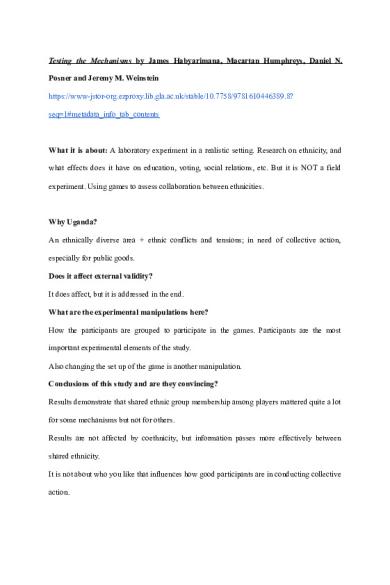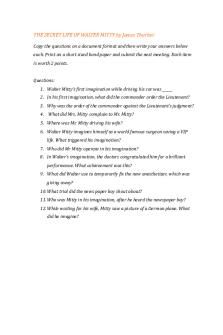Testing the Mechanisms by James Habyarimana PDF

| Title | Testing the Mechanisms by James Habyarimana |
|---|---|
| Course | Research Design |
| Institution | University of Glasgow |
| Pages | 3 |
| File Size | 92.3 KB |
| File Type | |
| Total Downloads | 94 |
| Total Views | 165 |
Summary
Summary of the reading Testing the Mechanisms by James Habyarimana...
Description
Testing the Mechanisms by James Habyarimana, Macartan Humphreys, Daniel N. Posner and Jeremy M. Weinstein https://www-jstor-org.ezproxy.lib.gla.ac.uk/stable/10.7758/9781610446389.8? seq=1#metadata_info_tab_contents
What it is about: A laboratory experiment in a realistic setting. Research on ethnicity, and what effects does it have on education, voting, social relations, etc. But it is NOT a field experiment. Using games to assess collaboration between ethnicities.
Why Uganda? An ethnically diverse area + ethnic conflicts and tensions; in need of collective action, especially for public goods. Does it affect external validity? It does affect, but it is addressed in the end. What are the experimental manipulations here? How the participants are grouped to participate in the games. Participants are the most important experimental elements of the study. Also changing the set up of the game is another manipulation. Conclusions of this study and are they convincing? Results demonstrate that shared ethnic group membership among players mattered quite a lot for some mechanisms but not for others. Results are not affected by coethnicity, but information passes more effectively between shared ethnicity. It is not about who you like that influences how good participants are in conducting collective action.
They find some evidence that between coethnics there is some technology that helps to be collectively effective, and there is also some support for strategy mechanisms, namely shared norms and norms of collaboration. Coethnics can interact better, and they share some norms that enforce collaboration, but it is not the choice for someone else.
What is Habyarimana et al. overall research question, and how do they break it down? (Hint: they talk about three types of mechanisms). Why does diversity impede collective action? Why coethnicity facilitates cooperation and why diversity, more generally, impedes collective action? The central aim of the research and the process is to distinguish between various storiesexamples of what we call preference, technology, and strategy selection mechanisms. How would you define the “games” Habyarimana et al. use? (e.g. the dictator-, lockbox-, discrimination-, or puzzle game). Computer-based experiments aimed to foster and research collective action (My definition, might not be correct) What type of research designs do Habyarimana et al. use to test the hypothesized mechanisms? Introduced an empirical strategy rooted in the methodology of experimental economics. Experimental design employed (which is the games that the participants play). Randomly selected whether they were playing with coethnic or non-coethnic partner. Assessing preference mechanisms. What are Habyarimana et al.’s key conclusions?
-
No evidence for the other-regarding preferences, the correlated preferences, or the preferences over process variants of the preferences mechanism
-
Found some evidence for the efficacy variant of the technology mechanism: coethnics do appear to be more effective than non-coethnics at working together on one of the two joint tasks studied.
-
Found compelling evidence that players condition their strategies on the ethnicity of the other players in the game....
Similar Free PDFs

Atomic Habits by James Clear
- 285 Pages

The mechanisms of spinal injury
- 6 Pages

The Dead - James Joyce
- 1 Pages

UT the Ultrasonic Testing
- 36 Pages

The boarding house - James Joyce
- 1 Pages

The Shooting of James Boyd
- 5 Pages
Popular Institutions
- Tinajero National High School - Annex
- Politeknik Caltex Riau
- Yokohama City University
- SGT University
- University of Al-Qadisiyah
- Divine Word College of Vigan
- Techniek College Rotterdam
- Universidade de Santiago
- Universiti Teknologi MARA Cawangan Johor Kampus Pasir Gudang
- Poltekkes Kemenkes Yogyakarta
- Baguio City National High School
- Colegio san marcos
- preparatoria uno
- Centro de Bachillerato Tecnológico Industrial y de Servicios No. 107
- Dalian Maritime University
- Quang Trung Secondary School
- Colegio Tecnológico en Informática
- Corporación Regional de Educación Superior
- Grupo CEDVA
- Dar Al Uloom University
- Centro de Estudios Preuniversitarios de la Universidad Nacional de Ingeniería
- 上智大学
- Aakash International School, Nuna Majara
- San Felipe Neri Catholic School
- Kang Chiao International School - New Taipei City
- Misamis Occidental National High School
- Institución Educativa Escuela Normal Juan Ladrilleros
- Kolehiyo ng Pantukan
- Batanes State College
- Instituto Continental
- Sekolah Menengah Kejuruan Kesehatan Kaltara (Tarakan)
- Colegio de La Inmaculada Concepcion - Cebu









